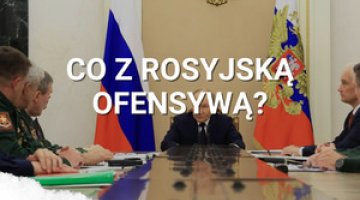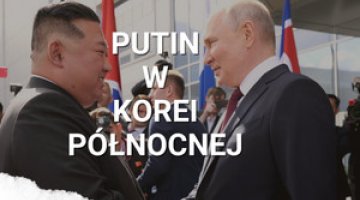Russia’s attack on Ukraine: day 70

Russian troops continue to shell and bomb Ukrainian positions in the combat areas and their deep hinterland. Mykolaiv and Kramatorsk fell victim to a massive rocket artillery strike (multiple launch rocket systems with a range of tens of kilometres). The rocket attack damaged, among others, railway infrastructure in Cherkasy and Dnipro, as well as facilities near Brovary in the Kiev Oblast and Kropyvnytskyi. Defenders reported that some enemy rockets were shot down. Delays in the movement of dozens of passenger trains have reached several hours. The information provided by the Ukrainian side from the battle areas is increasingly enigmatic or, as in the case of the situation in the Izyum-Barvinkove-Sloviansk triangle, non-existent.
The Ukrainians point to the increasingly intensive shelling of the border areas of the Chernihiv and Sumy oblasts and the expansion of enemy groupings on the opposite side of the border. Subdivisions of the 90th Tank Division from the Central Military District (MD) are to be developed in the Kursk Oblast, while in the Gomel Oblast the aggressor is increasing the number of air defence systems. Also, the exercises of special forces and electronic warfare subunits, which began in Belarus, are presented in the context of the threat of renewed Russian activity from the north. Kiev fears an armed provocation in this border region.
After a hiatus of nearly two weeks, the General Staff of the Armed Forces of Ukraine provided information on the invader’s personnel problems. Soldiers of the 38th Mechanised Brigade from the 35th Combined Arms Army (CAA) of the Eastern MD were to refuse further participation in the war. In turn, the subunits of the 2nd Army Corps (the so-called Lugansk People’s Militia) of the Southern MD, after being complemented with residents of the villages closest to the combat area, are characterised by a low moral and psychological state, have major problems with their weapons and are not ready to perform their tasks.
According to American data, two of the twelve battalion tactical groups that took part in capturing the city remained in Mariupol (they are supposed to number less than 2,000 soldiers). The remaining units were redeployed to the border of the Zaporizhzhia and Donetsk oblasts, in the area of Velyka Novosilka.
According to Ukrainian military intelligence, the aggressor is escalating the situation in Transnistria to create the appearance of preparing the Russian troops stationed there for an attack and to disperse and tie up the Ukrainian army in the next direction. The personnel of the Russian Army Operations Group in the Transnistrian region does not exceed 300 people, and the combined human potential of the Transnistrian and Russian forces is about 1,400 people. The territory of Transnistria may be useful for establishing supply lines for the invading troops. However, a condition for the success of this plan is the establishment of a land corridor through the southern regions of Ukraine, which, given the effective resistance of the defenders, currently seems unlikely.
The Ukrainian defence ministry has said that a covert mobilisation of unemployed and members of Cossack organisations is underway in the Belgorod and Kursk oblasts and the southern regions of Russia. Former military personnel residing in post-Soviet states are also being sought. They are to be offered to earn at least 200,000 roubles ($3,000) a month.
Over the past 24 hours, the State Emergency Service of Ukraine has demined an area of 396 ha and neutralised 1592 munitions and mines. Since the beginning of the war, 92,909 munitions and 583 kg of explosives, including 1964 aerial bombs, have been neutralised in an area of 17,000 ha.
On 4 May, Spanish law enforcement authorities – following a joint action by the Security Service of Ukraine (SBU) with the Prosecutor General’s Office and foreign partners – detained pro-Russian blogger Anatoly Shariy. In 2021 SBU charged him with treason and acting against national security in the information sphere. There is circumstantial evidence that he collaborated with Russian services. The activities of the Shariy Party were suspended in March. In 2021 Lithuania revoked his refugee status, granted in 2012.
On 5 May, an international conference of humanitarian donors for Ukraine is held in Warsaw at the level of heads of state, with the participation of, among others: the President of the European Council, the President of the European Commission, representatives of the World Bank, the IMF, the EBRD and international humanitarian organisations. On 4 May, Ursula von der Leyen, in her address to the European Parliament, called for joint work on an ‘ambitious’ post-war reconstruction package for Ukraine, in which the EU, together with international partners, should support all stages of its recovery, ensure the country’s sustainable development, further reforms and future membership of the Union.
On 4 May, the so-called Mariupol humanitarian corridor managed to evacuate 344 people – women, children and elderly people from Mariupol, Manhush, Berdyansk, Tokmak and Vasylivka – to Zaporizhzhia. From 5 to 7 May, the humanitarian corridor from the Azovstal plant is to operate again (the Russian side declares a ceasefire).
Since the outbreak of the war, 3.16 million people have entered Poland from Ukraine, with 25,000 on 4 May alone (a 28.5% increase on the previous day). In the opposite direction, 17.6 thousand people checked in on Wednesday, and 1.05 million since February 24. In turn, some 50,000 Ukrainian refugees have arrived in Lithuania since the beginning of the invasion, and more than 7,600 of them have already found work.
Commentary
- The intensification of strikes on transport infrastructure facilities is Russia’s direct response to the ongoing supply of heavy weaponry to the Ukrainian army from the West. It also signals that Moscow sees them as a direct threat to the success of its military operations. The repeated strikes against the same targets (including a railway bridge over the Dniester Estuary) show that at least some of the attacks were not carried out accurately and that the defenders managed to repair the damage relatively quickly. Attacks on new targets, however, confirm that these operations are causing difficulties. The Ukrainian side is looking for alternative routes to deliver equipment and supplies to the troops (the head of Ukrainian Railways reported that they were prepared for such a situation). While blocking supply lines from Poland and Slovakia should be considered extremely difficult and, given the current intensity of the fighting, downright impossible, transport from Romania to Odessa has been at least limited by the Russians.
- The increased activity of the aggressor’s forces to the north and north-east of Ukraine’s borders indicates an intention to continue blocking the Ukrainian units which remain there, so that they cannot be used in the combat areas in the south and east of the country (to reinforce the sub-units fighting there or to relieve them). Together with repeated missile strikes on Kiev and its surroundings, it is also intended to send a signal to the West, whose representatives have in recent weeks been increasingly bold in visiting the Ukrainian capital and restoring diplomatic missions there.
- Shariy’s detention by Spanish law enforcement authorities is a warning to all pro-Russian politicians or activists who fled Ukraine (mostly to EU countries, Israel and the UAE) after the war began. A controversial politician Illia Kyva, who had made declarations of loyalty to Moscow and called for the assassination of President Volodymyr Zelensky and the bombing of Lviv, also previously stayed in Spain but fled to Russian after an international arrest warrant was sent for him in March. Such individuals have previously been the target of sanctions in countries sympathetic to Ukraine, which Spain for years served as a safe haven to many figures from the underworld of Ukraine and Russia. However, the current actions of Spain show that the Russian aggression is changing the attitude of countries hitherto disinterested in the EU’s eastern neighbourhood.




